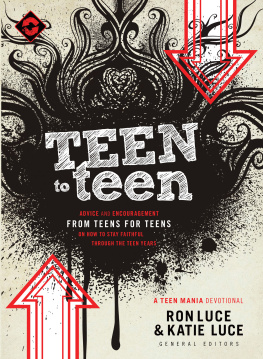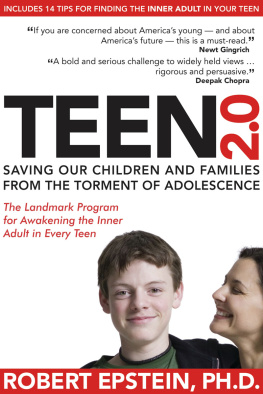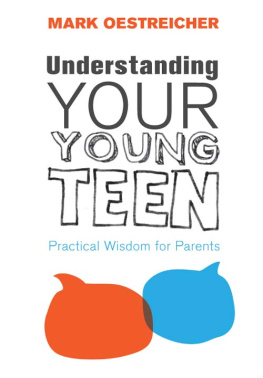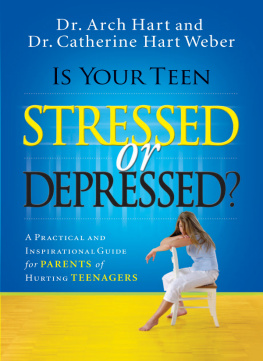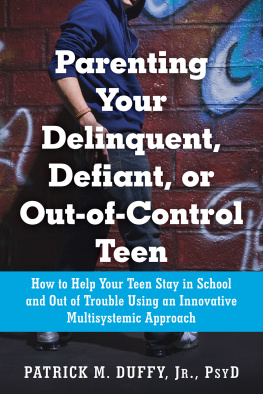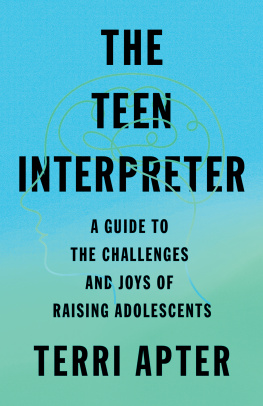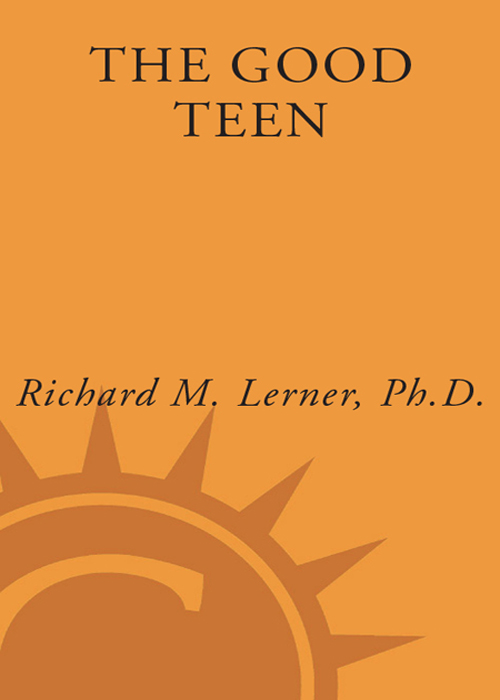
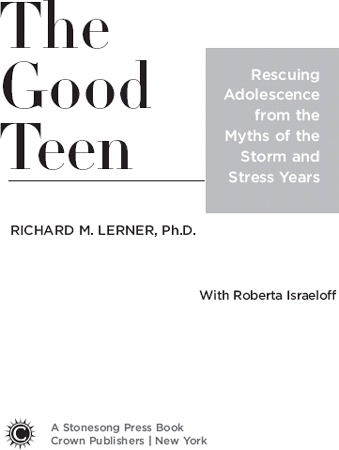
Contents
To Justin Samuel Lerner, Blair Elizabeth Lerner,
and Jarrett Maxwell Lerner: from terrific teens
to extraordinary young adults
What We Can Learn from Tom and Huck
TOM!
No answer.
TOM!
No answer.
Whats gone with that boy, I wonder? You TOM!
No answer.
Mark Twain, The Adventures of Tom Sawyer (1876)
I think we can all empathize with poor Aunt Polly. How many times have we called to our adolescent children repeatedly, our voices growing louder and louder, and still received no answer? More than a quarter century before adolescence even became a field of scientific study, Mark Twain captured what for many parents was a universal view of teenagers: they were troublesome and troubled. And if Aunt Polly had a problem dealing with young Tom, well then, when it came to his friend Huck Finn, there was just no hope.
Yet one of the features that makes Mark Twains novels endure is that their author surprised us each time we turned the page, following these two young adolescents on their adventures. Yes, both boys were more than a handful to deal with. Aunt Polly was always at her wits end contending with all the mischief her nephew and his friend kicked up. However, by the time we finish The Adventures of Tom Sawyer and The Adventures of Huckleberry Finn, we discover that Toms and Hucks problem behaviors were only a partand a very small partof who they were. Sure, the boys were mischievous, but they also showed great courage. At great risk to their own lives and even in the face of social disapproval, they stood up against crime and racial discrimination. They had character; they were loyal to friends and to family. They were also ingenious and able to solve problems, and they had enough stick-to-it-iveness to keep their promises and commitments, even against great odds. And they possessed the ability to love.
We can easily appreciate why Twain was such a captivating storyteller. He roped us in by making us believe that he was going to recount the adventures of two problem-filled adolescents. Instead, what he showed us was that although the boys had problems and flaws, they possessed extraordinary strengths. He encouraged us to overcome our own stereotypical expectations of teenagers and see these two boys as complete human beings. Overall, they were young people to admire and to value.
A METAPHOR FOR OUR TIMES
Twains novels about Tom and Huck may be regarded as a metaphor for all American youth and perhaps all Americans. More than a century ago, his books conveyed the message that we should look beyond what may be an annoying characteristic or a shortcoming of our children and even of ourselves. Twain reminds us to keep our eyes wide open and allow the breadth of the person to be understood and appreciated. There is more to young people than just those irksome aspects of their behavior that may cause you worry. America and its youth had problems in the postCivil War years during which Twain wrote these novels. Yet the individuals in this nation, and the nation itself, had considerable strengths, and these strengths, he believed, outweighed the problems.
Twain gave us this message of hope more than 125 years ago. Today, there are exciting results coming in from new research about Americas youth. Much of this research comes from the 4-H Study of Positive Youth Development, a research project within my own laboratory, the Institute for Applied Research in Youth Development at Tufts University. Over the course of this book, I will tell you about the results of my research and, as well, the research of my colleagues across the nation who are learning similar things about the strengths present in all young people and about our hope for enhancing the positive development of all our children.
These innovative findings reinforce Twains wisdom. Unfortunately, in the years that have passed between the publication of Twains novels and the emergence of todays new data, many of usparents and scientists includedhave lost sight of the lessons we learned about young people from Tom and Huck.
All too often, parents have acted as if the only important aspects of their childrens behaviors were those that caused problems. We think of adolescence as a time of storm and stress. Scientists, too, have regarded young people as lacking, as deficient, as unable to behave correctly and in a healthy manner. We characterize them as dangerous to others and as endangered themselves (because of their self-destructive behaviors).
Given this perspective on teenagers, researchers devoted their energies to finding ways to prevent young people from becoming all the bad things they could become. Therapists, too, used this deficit approach when treating young people. If their problems could not be prevented, then therapists searched for ways to reduce the impact of their shortcomings. Everyone focused on the problems. Experts of all types did not look to see if, in succeeding chapters of life, there were unnoticed strengths and admirable qualities that should be reinforced.
The Good Teen seeks to correct this imbalance. We do not need to see our young people as, essentially, repositories of problems. Instead of dwelling on their weaknesses, we can concentrate on their strengths.
Theres no denying that adolescence can be a tumultuous time and that teenagers sometimes act out, at times egregiously. Its not all smooth sailing. Just ask Aunt PollyTom gave her fits. All children do, at times. No adolescent is free of problems. So whats the best way to handle this reality?
It would have been incorrect for Aunt Polly to resort to strict punishment (once the preferred method for managing childrens unruliness) or to think of it as her only option for treating Toms behavioralthough of course she certainly considered this alternative throughout the novel. It would be just as wrongheaded today to accept child-rearing options such as tough love, boot camp, and other flashy practices that advocate punishment to quell what we regard as childrens inevitable rambunctious, disobedient, and troubling behavior. Such approaches are misguided and downright dangerous now that we have so much research to support the idea that all youthno matter what their backgrounds or characteristicshave the potential to develop in more positive and healthy directions.
The Good Teen will explain how you can help your teenagers write an optimistic script for this phase of their maturation. Even if your children remind you of Tom and Huck, they will mostly likely grow up to lead successful, fulfilling lives, contributing positively to their own development and to that of their families, communities, and ultimately our nation and society. By taking to heart the messages emerging from this new research, which we will discuss, you can collaborate with your teenager at home, in school, and in your neighborhood to make certain that the story ends in a positive way. How? Keep your eyes open. Look for the bigger picturethe full storyabout your child. Dont draw a conclusion about how the story will end by just reading the first chapter. Keeping this rule in mind may be very difficult at times, but it will pay off.
Consider Nancy. It was a Sunday evening, and Nancy found herself in the kitchen preparing a batch of pancakes for dinner. Ever since they were little, her kidsseventeen-year-old Eric and fifteen-year-old Donnaloved the idea of having breakfast at night. It had been a family tradition for more years than Nancy could remember. When the kids were younger, they used to help her, adding the ingredients, mixing the batter, and setting the table.
Next page

